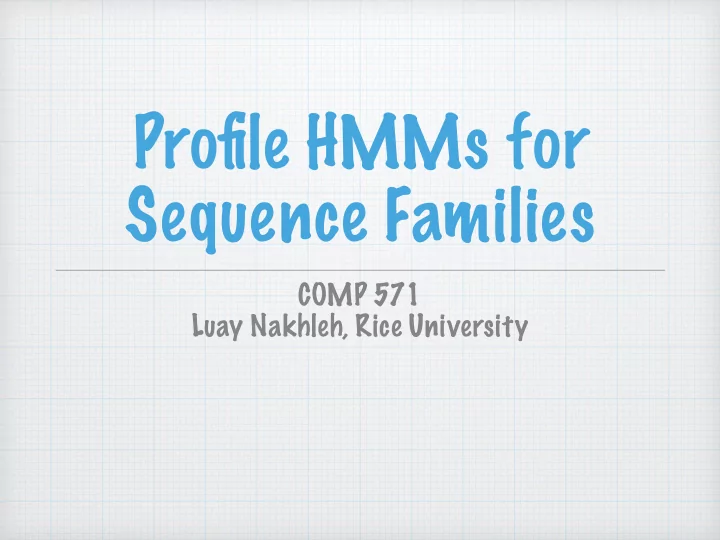

Profile HMMs for Sequence Families COMP 571 Luay Nakhleh, Rice University
Sequence Families Functional biological sequences typically come in families Sequences in a family have diverged during evolution, but normally maintain the same or a related function Thus, identifying that a sequence belongs to a family tells about its function
HMM Profile Consensus modeling of the family using a probabilistic model Built from a given multiple alignment (assumed to be correct)
Sequences from a Globin Family Alignment of 7 globins The 8 alpha helices are shown as A-H above the alignment
Ungapped Score Matrices A natural probabilistic model for a conserved region would be to specify independent probabilities e i (a) of observing amino acid a in position i The probability of a new sequence x according to this model is L Y P ( x | M ) = e i ( x i ) i =1
Log-odds Ratio We are interested in the ratio of the probability to the probability of x under the random model L log e i ( x i ) X S = q x i i =1 Position specific score matrix (PSSM)
Adding Indels to Obtain a Profile HMM � Silent � deletion states Insertion states Match states Profile HMMs generalize pairwise alignment
Deriving Profile HMMs from Multiple Alignments Essentially, we want to build a model representing the consensus sequence for a family, rather than the sequence of any particular member Non-probabilistic profiles and profile HMMs
Non-probabilistic Profiles Gribskov, McLachlan, and Eisenberg 1987 No underlying probabilistic model, but rather assigned position specific scores for each match state and gap penalty The score for each consensus position is set to the average of the standard substitution scores from all the residues in the corresponding multiple sequence alignment column
Non-probabilistic Profiles The score for residue � a � in column 1 s(a,b) : standard substitution matrix
Non-probabilistic Profiles They also set gap penalties for each column using a heuristic equation that decreases the cost of a gap according to the length of the longest gap observed in the multiple alignment spanning the column
Problem with the Approach If we had an alignment with 100 sequences, all with a cysteine (C), at some position, the probability distribution for that column for an “ average” profile would be exactly the same as would be derived from a single sequence Doesn’t correspond to our expectation that the likelihood of a cysteine should go up as we see more confirming examples
Similar Problem with Gaps Scores for a deletion in columns 2 and 4 would be set to the same value More reasonable to set the probability of a new gap opening to be higher in column 4
Basic Profile HMM Parameterization A profile HMM defines a probability distribution over the whole space of sequences The aim of parameterization is to make this distribution peak around members of the family Parameters: probabilities and the length of the model
Model Length A simple rule that works well in practice is that columns that are more than half gap characters should be modeled by inserts
Probability Values A k ` E k ( a ) a k ` = e k ( a ) = P ` 0 A k ` 0 P a 0 E k ( a 0 ) indices over states k, ` : transition and emission probabilities a k ` , e k ( a ) : transition and emission frequencies A k ` , E k ( a ) :
Problem with the Approach Transitions and emissions that don’t appear in the training data set would acquire zero probability (would never be allowed) Solution: add pseudo-counts to the observed frequencies Simples pseudo-count is Laplace’s rule: add one to each frequency
Example
Example: Full Profile HMM
Searching with Profile HMMs One of the main purposes of developing profile HMMs is to use them to detect potential membership in a family We can either use Viterbi algorithm to get the most probable alignment or the forward algorithm to calculate the full probability of the sequence summed over all possible paths
Viterbi Algorithm
Forward Algorithm
Questions?
Recommend
More recommend